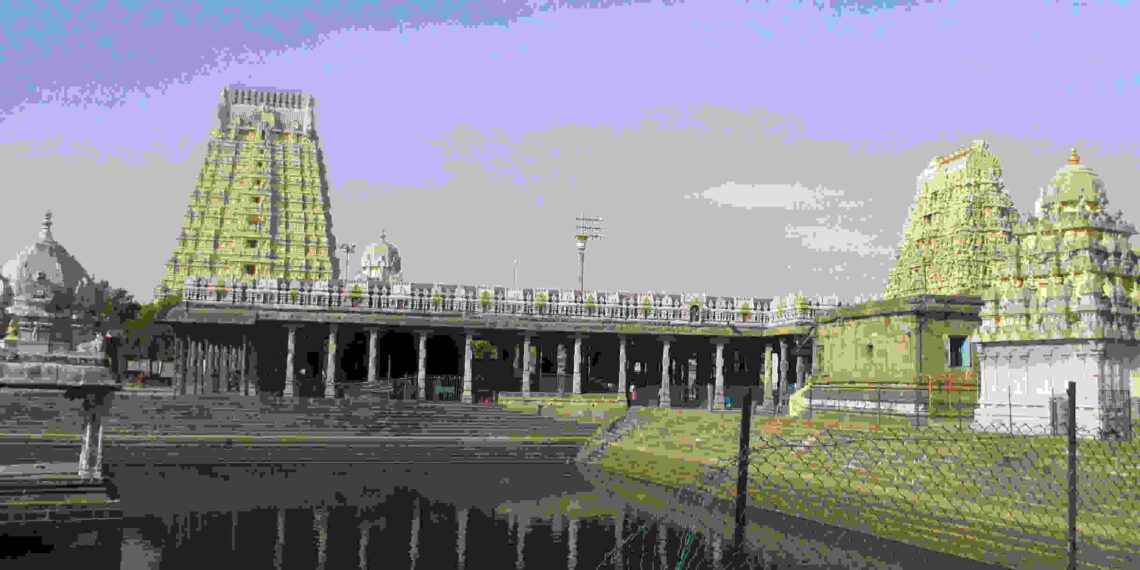The Ekambareswarar Temple is a holy kshetra for Lord Shiva, worshipped as Ekambareswarar, located in Kanchipuram, Tamil Nadu just 75 km from Chennai, a short bus or train ride away. It is one of the Pancha Bhoota Sthalams, connected to the element of earth. Covering 25 acres, its tall gopuram, wide courtyards, and an ancient mango tree bring in pilgrims from all over India. The temple is often lauded as one of the best example of Tamil culture in South India.
Legend of the Temple
The legends associated with the temple is very interesting. Goddess Parvati once undertook a intense penance in order to have Lord Shiva as her husband under the mango tree near the Vegavati River. Wanting to test her devotion, Lord Shiva lit fire around her. To seek help, Mother Parvati began praying to her brother, Lord Vishnu. To save Parvati, Vishnu took out the moon from Lord Shiva’s head and showered his rays into the mango tree and Parvati to cool it down.
To check how persistent and concentrated Parvati is, Lord Shiva again sent river Ganga to threaten and disrupt Parvati’s penance. However, Parvati requested Ganga and convinced her that they are sisters and worship the same supreme power, Lord Shiva. Ganga accepted her request and did not harm her and agreed not to disrupt her penance. There, she made a lingam from the earth(Parthiva lingam) under a mango tree and worshipped with full devotion. Shiva, pleased, forgave her, and the lingam became the temple’s core, called Ekambareswarar, meaning “Lord of the Mango Tree.” Some say the lingam is sand, shaped by Parvati’s hands. The mango tree, said to be thousands of years old, still stands, its fruit tied to her devotion.
History of Ekambareswarar Temple
The temple’s history goes back to the 6th to 9th centuries. The Tevaram hymns sung by saints Sambandar, Appar, and Sundarar name it a Paadal Petra Sthalam, a special Shiva shrine. Worship here may have started in the 4th century, but the current temple structure grew later. The Pallava kings, from the 6th to 9th centuries, began it initially, building simple structures for Shiva.
The Chola kings, from the 9th to 13th centuries, added more structures, like halls and intricate carvings. Stone records show rulers like Kulothunga Chola I giving land, gold, and oil for lamps. The Vijayanagara kings, from the 14th to 16th centuries, built the 192-foot gopuram, one of South India’s tallest, and added detailed pillars. The Nayaks of Thanjavur carved scenes in great details that it still stand out today.
In the 1300s, northern islamic invaders disrupted the temple rituals, but priests kept temple safe. The Vijayanagara kings later brought back the rituals. In the 1700s, the French held Kanchipuram in 1757, the British in 1760, and Tippu Sultan’s rule came in 1790. Despite these changes, the temple stayed strong. By 1855, the British managed it, and in 1951, Tamil Nadu’s HR&CE Board took over, keeping its ways alive.
The temple’s spiritual history lives in the Tevaram and songs by saints like Manikkavasagar. Its role as a Saiva center keeps it important.
Architecture of the Temple
The Ekambareswarar Temple is built in Dravidian style, covering 25 acres. Its main gopuram, 192 feet tall, is covered with carvings of gods, divine dancers, and stories. Smaller gopurams and courtyards lead to the lingam, said to be self-born, in a plain shrine. Parvati’s shrine, as Kamakshi, is nearby.
The thousand-pillared hall, built by the Vijayanagara kings, has carvings of Shiva’s stories and warriors. A mango tree, tied to the legend, grows in the courtyard. The Kampai Tirtha tank reflects the gopuram. Shrines for Ganesha, Murugan, and Vishnu are scattered around. Some wall carvings from Nayak times show old stories, making every step a look into history.
Religious Significance
For Saivites, the temple is a key place, one of the Pancha Bhoota Sthalams, tied to earth. The legend of Parvati’s lingam makes it a spot for seeking forgiveness and grace. People pray for peace or strength, offering flowers or joining abhishekam.
As a Paadal Petra Sthalam, it’s a major pilgrimage site, named in the Tevaram. Its role in Saiva tradition, built by saints and devotees, draws those seeking the divine.
Festivals and Rituals
Festivals bring the temple to life. Panguni Uthiram, in March or April, celebrates Shiva and Parvati’s union with processions and music. Maha Shivaratri has night-long prayers. Six daily rituals, from morning to night, led by priests, keep the temple’s rhythm with chants and offerings.
Conclusion
The temple is an intricate part of Tamil culture. The Tevaram hymns and saintly songs started here, shaping Saiva beliefs in the region. Festivals with music, stories and dance, kept Tamil arts alive, and the carvings show life from ancient times. The Ekambareswarar Temple calls those devoted to Lord Shiva, thousands in number, from all over India whose divine presence is felt throughout the temple complex.











